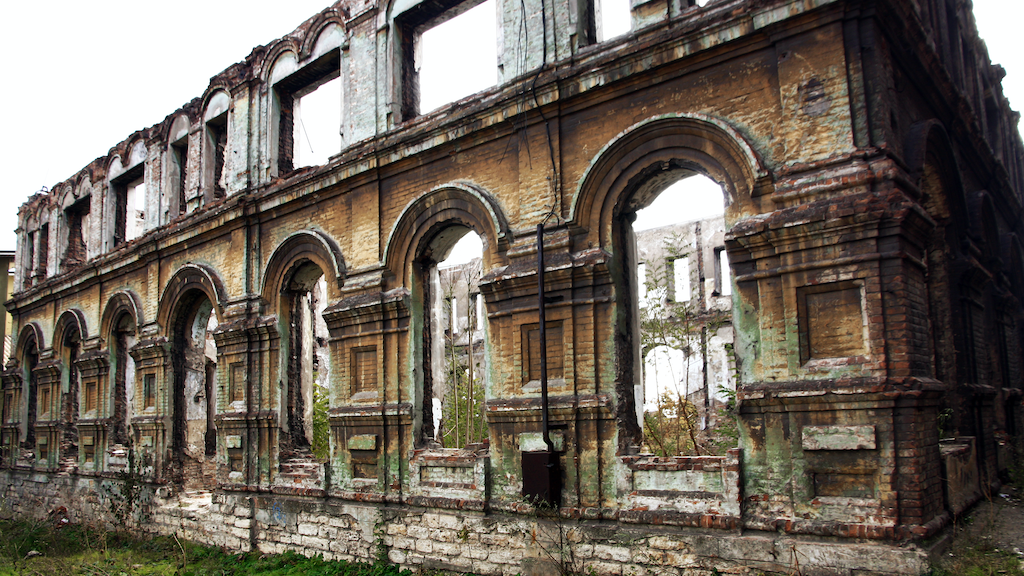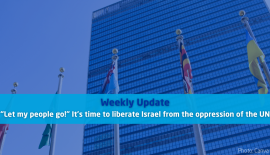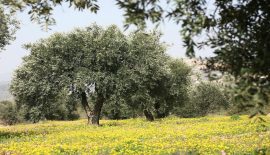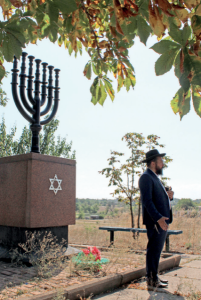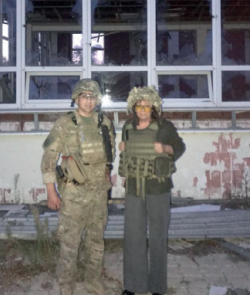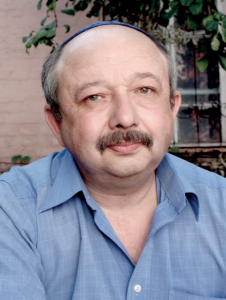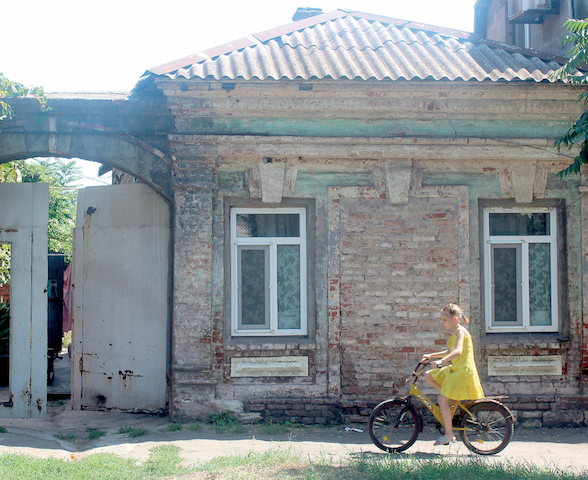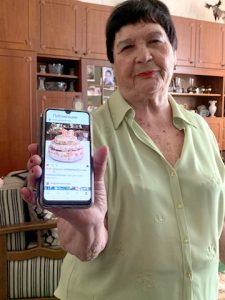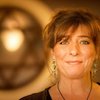Trapped in a Forgotten War
Jews in the Ukrainian beach city of Mariupol desperately try to stay afloat as they seek to put a face to the tragic, unrecognized Ukrainian history of the Shoah: A report from a conflict-torn region.
As you drive through the gently rolling hills of eastern Ukraine it is not hard to guess why the country’s flag has two stripes: blue above, yellow beneath. Under an endless blue sky, vast fields of grain and sunflowers ripen. It is a three hour drive over a highway with deep potholes and eroded asphalt, which is being renewed in various places. No unnecessary luxury, especially considering that the coastal city where we are going, Mariupol, is less than fifteen kilometers from the front of the internationally unrecognized, Russian supported, Peoples’ Republic of Donetsk.
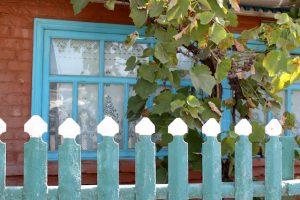 The Mariupol airport is closed to civilian air traffic; we are not able to get any closer than the airport of Zaporizhia, about 200 kilometers away. So now we are on our way from there to the southeast by road. In the Netherlands we only hear about this forgotten war in Europe’s backyard when there is a connection with the shooting down of flight MH17. Newspapers report a cease-fire, but we will later realize that there is no such thing. To enter the city, we must pass multiple checkpoints.
The Mariupol airport is closed to civilian air traffic; we are not able to get any closer than the airport of Zaporizhia, about 200 kilometers away. So now we are on our way from there to the southeast by road. In the Netherlands we only hear about this forgotten war in Europe’s backyard when there is a connection with the shooting down of flight MH17. Newspapers report a cease-fire, but we will later realize that there is no such thing. To enter the city, we must pass multiple checkpoints.
Columns of smoke
Mariupol is not exactly the kind of beach location where you might imagine spending your vacation. It is bleak. Just outside the center of the city we see countless columns of industrial smoke. Mariupol is known as the most polluted city in Europe. It is also home base to Rabbi Mendel Cohen, who was in the city when pro-Russian rebels invaded with Vladimir Putin’s help in 2014. Mendel Cohen wanted to stay with his kehilla up to the very last moment, but when he was ordered to leave immediately, right away, he was able to escape with not a moment to spare. Shortly after, the city was under rebel control. Many residents of the city had Russian pins ready, to “welcome” them. They chose to play it safe and feared the same situation as in Crimea, where the Russians had invaded earlier that year and that had been annexed by Russia. Mariupol had been a pro-Russian Ukrainian city for quite some time, but that attitude shifted after the invasion. With great difficulty the Ukrainian army managed to regain control over Mariupol, but the unrest continued for years. Rabbi Mendel, born and raised in the Israeli city of Haifa, traveled back and forth to the remaining Jewish residents for the Jewish holidays. They were joined by Jewish refugees from rebel-controlled territory, who were received by his community to the best of their ability.
A front row view
After the small Dutch delegation from Christians for Israel, with whom I am traveling, has checked into the hotel, two Ukrainian military vehicles stop in front of the door. One of the passengers is Commander Pavlo Khazan, a Jew and a good friend of Rabbi Mendel. Before the war Khazan was actively involved in the international environmentalism movement. He was a pollution analyst who filled his days taking [environmental] samples in Ukraine, a country ravaged by heavy industry and the Chernobyl nuclear disaster and fighting against the large factories that pollute the country. He had ties with Friends of the Earth Netherlands and had even spoken in Amsterdam at meetings with Shell. But now he has a greater challenge. Khazan leads a relatively new unit of the Ukrainian army that specializes in communication and intelligence.
If we want, he can take three people to the front this evening. Well, not the front exactly, but to a front row seat, some five hundred meters away [from the front itself]. Requirements: Wear a helmet, dark clothing and a bullet-proof vest. A little later, a father and son pair named Prins and I climb into Khazan’s vehicle. Wearing a much too large helmet that keeps trying to roll off of my head, we soon arrive in the war zone. As a journalist I am aware that I am only describing one side of the conflict now, but this evening demonstrates that the “cease-fire” reported by the western media is just a word and that it looks quite different here on the ground. Just yesterday seven Ukrainian soldiers lost their lives in the fighting.
Gunfire
We drive to Shyrokyne, a few kilometers along the coast from Mariupol, which we approach at dusk. From a distance we see beautiful mansions, until we get closer and see the destruction of war: Shyrokyne has become a ghost town, walls pockmarked with bullet holes, roofs destroyed by bombing. Before 2014 Shyrokyne was a beach town where many Ukrainians spent the summer. We walk through what was once a vacation resort – now shot to ruins. We skirt deep holes which lead to an underground tunnel system. In front of a ruined gym we are allowed to stop for a short minute to quickly take a few pictures. In the background we can hear gunfire. It is dark by now. We are in the “front row” for no longer than ten minutes, but we have been able get a good impression of the destruction. From a hilltop a bit further on we look out over what must have been high-class accommodations on the beach. Everything is deserted and again we hear shots in the background: snipers, Khazan explains.
Surreal
“Don’t leave the road. Mines.” he says. We drive away past shot-up estates. Khazan puts music on. I hear the tones of a Ladino singer. “That’s Ladino!” I exclaim. “Yes, that’s right.” he answers. “I have both Ashkenazi and Sephardic roots. My brother lives in Spain now; he took advantage of the new Spanish regulation allowing Jews who were exiled during the inquisition to return.”
This is a completely surreal situation: wearing a strange helmet and bullet-proof vest, on the Ukrainian-Russian front, with a Jewish commander in an army vehicle with Ladino music in the background. You can’t make this stuff up. But this evening, in eastern Ukraine, it is real.
On the way back to Mariupol we pas three or four more army roadblocks. You can see some of the soldiers staring at us Dutch people with a look that seems to say, “What are those idiots doing here?”
“Extremely hard”
It’s the next day. Just a short walk from the hotel is the Jewish community center run by Rabbi Mendel, who connected with Christians for Israel through chief rabbi of the Netherlands, Binyomin Jacobs. It is situated on the Mariupol street that once formed the heart of the Jewish community here. In the community center we hear the firsthand account of how the war has disrupted the lives of this former shtetl’s residents. Engineer Osher Kriatchkov, now a member of the Jewish community in Mariupol, tells his story. Up until 2014 he lived in a large house in Shyrokyne together with his wife, daughter, and other family members. In 2014 that changed abruptly when he and his family were evacuated at a moment’s notice. “My wife was born and raised there. When we had to go, my father-in-law refused to leave. He stayed there for several more weeks, hiding in the basement, only going outside at night under the cover of darkness to call and tell us that he had survived the day, because he only had cell reception outdoors.” He is crying. “Finally, a few weeks later, he crossed the border too, going through the fields. Thankfully he made it.”
“The first six months here in Mariupol were extremely hard. My bank account had been frozen, I couldn’t access my money. Rabbi Mendel’s kehilla took us in. Thank God we received food parcels put together by the team of Christians for Israel Ukraine,” Osher tells us. “We only went back to our house one time, secretly in a small car in 2015. We retrieved as many things as we could then. Everything was relatively intact. We have never been back since. Last year a soldier filmed the inside of our house at our request. Would you like to see it?”
Crossing the border illegally
We see images of a completely shot out building. You can hear the shards of glass breaking into even finer shards under the weight of the soldier behind the camera. Several of Osher’s blazers are still hanging in a closet with torn-off doors, some of his wife’s shoes lined up underneath. Would he consider immigrating to Israel? “We can’t because my wife is not Jewish. I hope that one day we can return to Shyrokyne. My daughter is eight. She would love to have pets but that isn’t possible in the small apartment where we all live now. When we are back, she can have all the cats, dogs, and rabbits she wants, just not now. Try explaining that to her.”
Another member of Mendel’s kehilla who fled here is Ilia Lukovenko, former professor of philosophy at the university in Donetsk. He would have preferred to evacuate sooner, “But my mother was seriously ill and we hoped that the war would be over soon. But the war didn’t end, the situation just became worse. I knew that I really needed to leave when my good friend Igor Kazlevsky, the rector of the university, was arrested. He was sentenced to two years in prison for speaking out against the occupation. At that point I crossed the border illegally. My wife and child followed later.”
Mass grave
Once again we bounce along nearly impassable roads. With Rabbi Mendel Cohen as our guide, we are on our way to a small village west of Mariupol, Ahrobaza, where one of Ukraine’s many Jewish mass graves is located.
According to well-founded estimates some 1.3 million of the 6 million Jews who were murdered during the Shoah came from Ukraine. Thousands of them lie in the small village of Ahrobaza, about three kilometers west of Mariupol. Our first impression of the village on this sunny day is a peaceful one. We see houses that could use a bit of paint, a few supermarkets where we park our vans and buy water – tap water is not safe to drink in Ukraine. Following the rabbi we walk over hills covered in dry grass where a handful of cows are graze.
The tranquility is deceptive, considering the history. There is no sign pointing the way to the mass grave or telling us where to go to pay our respects. A helpful resident tells Mendel how to get there. He is unfazed by the rabbi’s orthodox Jewish clothing as he calmly gives directions.
This is where all the Jewish inhabitants of Mariupol were brought, early in 1941. Their place of departure in the city is clearly marked with a plaque. How many people there were in total is unclear up to the present day. Some sources mention 9,000, others up to 30,000.
After a night locked up in a building that is now in total ruin, the entire Jewish population of Mariupol – men, women, and children – were shot one by one and dumped in shallow trenches. Up to three days later the residents of Ahrobaza heard cries from the mass grave, from which a few people were able to be rescued. No one knows exactly how big this field of death is. Some tell of a sixteen kilometer long trench. On days with heavy rain bones and skulls become exposed. Rabbi Mendel hopes to use a scanner to find the limits of the mass grave without needing to exhume remains – partly because of the planned expansion of the neighboring Christian cemetery. One of the people we travel with has promised to arrange for a scanner.
Yizkor is said at a simple memorial. Then there is a moment of silence. The wind rustles in the waving grass and the dying leaves of the chestnut trees, as though thousands of voices are whispering what happened here. Mendel says, “All I want is a fence around this area, so that the people lying here can rest in peace, without having their bones trampled by cows.”
Cakes on Instagram
There is no time to quietly reflect on all of this. An hour later, back in the city of Mariupol, we visit Wanda (87 years old). She lives in a suburb in a one-room apartment that is reminiscent of a third world country. Wanda wants her grandson to immigrate to Israel but is missing the documentation that her mother was Jewish. Thanks to her years of service as a government worker she has to make ends meet on a pension (that is quite reasonable by Ukrainian standards) of 120 euros a month. “Without the food parcels from Christians for Israel I would be long dead,” she says.
Not much later we are sitting in the nicer apartment where 88-year-old Alina lives. As a young girl she saw all the Jews being gathered to be taken to Ahrobaza in 1941. Her parents refused to obey the order to report [for transport. They went into hiding, managing to survive the war. Alina’s home is filled with pictures of her children, grandchildren and great-grandchildren. Her slightly older husband follows her every movement, at least when he hasn’t slipped out to the balcony to smoke a cigarette. The vodka is taken out of the cupboard. Politely declining – it is just 4 o’clock in the afternoon – is not an option. There is plenty of laughter. Rabbi Mendel says to her husband, “How have you managed to live with her for so long?” She jumps in with, “You’d better ask him how I managed to live with his mother for 42 years.” Alina, who survived it all, has an Instagram page with thousands of followers. The whole world needs to see how beautiful her home-baked cakes are.
Few written sources on the Jewish history of Mariupol have survived, but it is generally accepted that it began in 1820. Jewish life blossomed there after the Crimean War, when the city on the Sea of Azov (an extension of the Black Sea) experienced great economic expansion. Most of the Jewish immigrants were tradespeople. The Jews were not the only minority population coming into the city; even today there is still a large Greek minority, with whom the Jewish community has always had fairly good ties.The first synagogue was not built until 1864, in the Kharlampievskaystreet, which still forms the heart of the Jewish community in the present day. Across from the synagogue was a building where poor Jewish immigrants were given shelter, there was a mikveh, a Talmud-Torah school for poor Jews, a school for girls, a matzo bakery a little further up the street, and near the city park there was a Jewish hospital. More synagogues were built in the city, few of which remained. The great synagogue built in 1882 had an aura of class and grandeur and because of this was named chief synagogue. Now it is a ruin.
Pogrom
Some numbers are known relating to the growth of the Jewish population of the city in the second half of the nineteenth century. In one geographical statistic we read, “In 1864 the city of Mariupol counted 7,740 inhabitants; there were 393 Jews.” An 1884 census reveals that of the 161,044 inhabitants three percent or about 5,000 were Jewish. In 1896 there were 7,862. Because the city was multicultural, Jews had it relatively easy compared to other parts of the Russian empire. But antisemitism simmered under the surface. In present day Ukraine you can still hear the expression, “If no water comes from the tap it is because the Jews drank it.” In 1905 it led to a pogrom: 21 Jews were massacred, their shops and homes looted.After World War I, Mariupol developed into an important industrial city. Many Jews were now allowed to work for governmental organizations or found jobs at one of the many factories.
A cause for concern
In 1939 the community had 10,444 members. Then the Shoah came. Practically the entire Jewish population was murdered by the Nazis in October 1941, readily aided by a number of Ukrainian residents. Starting in September 1943 the city was under Stalin’s communism. On August 24th, 1991 the country declared independence; before the end of the Soviet Union. However, big brother Russia continued to drool over Ukraine’s harbors on the Black Sea, including Crimea – which Putin invaded in 2014, and later the region of Donetsk as well, including Mariupol.Antisemitism remains a cause for concern in Mariupol. Jews can lead a fairly quiet life – people wearing kippahs are left alone – but just last year June the Jewish cemetery was seriously damaged [by vandals]. About 2,500 Jews live in the city, which has a current population of about 500,000.
Esther Voet travelled to Ukraine for the first time together with Christians for Israel in 2019.
